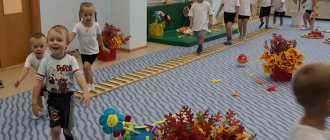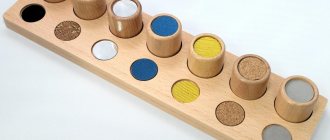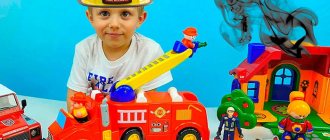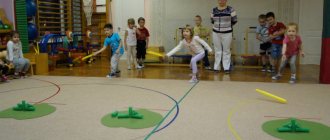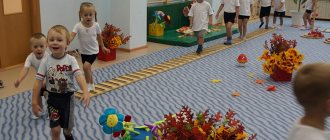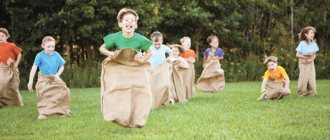Modification of the outdoor game "Cat and Mouse"
GAME “CAT AND MOUSE”.
Goal: to develop manual dexterity, attention, sense of rhythm, verbal memory, group cooperation, mutual assistance.
Equipment and materials for the game: you can prepare elements of cat and mouse costumes (hats, tails)
Choosing a leader and supervisor: It is better to play the game with a teacher who explains the rules and monitors the progress of the game. To select cats and mice, you can use a chant that is pronounced during the game - this helps children learn the text at the same time:
The mice walk in circles.
The cat is dozing on the sofa.
Quiet, mouse-free, no noise.
Don't wake up the cat Vaska:
When Vaska the cat wakes up.
Stop the round dance!
Game description: Players dance in a circle with the mouse in the center - this is the “house” - saying or singing the words. As soon as the song ends, the players understand their hands without opening them - “the door is open”, the mouse runs out and runs away from the cat waiting for it behind the carousel.
Rules and conditions of the game:
If the cat manages to catch the mouse, the game ends. You can force the cat to become a mouse or choose a new pair.
The cat is not allowed to run into the circle.
The mouse cannot stay too long during the chase - it must immediately run in and out.
Players in the circle must be attentive and careful - they must not lower their hands too much so as not to hurt the leaders.
Possibility to complicate the game: you can choose two mice or two cats.
Chapter 2.
Game “Cat and Mouse” (5-7 years old).
Goal: to develop dexterity, speed, intelligence, attention, coordination of movements with words.
Running exercise with dodging, catching and forming a circle.
Equipment and material for the game: elements of a cat and mouse costume (hats, ribbons).
Number of participants: 25-30 people.
Choosing a leader and coach: The teacher should act as a leader, explaining the rules and monitoring the progress of the game.
The mice stand in a circle, and each mouse receives a strip of colored fabric or a ribbon, which it glues to the strip on its back. A cat sleeps in the center of the circle, the mice dance, pronouncing or singing words.
The mice dance in a circle.
The cat is dozing on the sofa.
Quiet, mice, don't make noise.
Don't wake up the cat Vaska:
When the cat Vasya wakes up.
He will break up the whole dance!
When the song ended, the mice scattered across the playground. The cat woke up and ran after the mice, trying to snatch a ribbon from one of them. The mouse, deprived of its ribbon, temporarily moves away.
At the teacher’s signal, the children stand in a circle, and the cat counts the number of ribbons he took and returns them to the mice.
What else to read: Folk game “Ring-Ring”: learn the rules, have fun!
Each time the game lasts no more than 1-2 minutes, and the total duration is 5-7 minutes.
Rules and conditions of the game:
| 1 | The tape cannot be held in your hands. |
| 2 | If the cat cannot pull out any ribbon within 1-2 minutes, the trainer assigns another ribbon to the cat. |
| 3 | The tape should be positioned behind the tape so that the end hangs down and can be easily grasped by hand. |
| 4 | At the end of the game, the teacher writes down those cats that managed to snatch the most ribbons, and those mice that did not lose a single ribbon. |
If the area is large, it is necessary to mark its boundaries with flags or contour lines so that mice, when running away from the cat, do not run across the boundaries.
Possibilities for complicating the game:
1.You can choose two cats.
Game “Cat and Mouse” (5-7 years old).
Goal: to develop agility, jumping ability, attention, sense of rhythm, verbal memory.
Equipment and materials for the game: you can prepare elements of a cat and mouse costume (hats, tails).
Number of participants: 25-30 people.
Choosing a leader and mentor: It is best if the leader is a teacher who will explain the rules and control the progress of the game.
Instructions for the game: A circle is drawn on the ground, and one of the players stands in the center of the circle - this is the cat.
The mice dance in a round dance.
The cat is dozing on the sofa.
Quiet, mice, don't make noise.
Don't wake up the cat Vaska:
When the cat Vasya wakes up.
He will break the whole circle!
After these words, the mice jump over the line of the circle and, if there is no danger of being caught by the cat, remain inside the circle for some time. Continue to hop on two feet in place or move forward toward the center of the circle. The mice try to avoid the cat and jump out of the circle in time. The one caught by the cat becomes a cat, and the cat becomes a mouse.
The game lasts no more than 1-2 minutes each time, and the total duration is 5-7 minutes.
Rules and conditions of the game:
1. Players can only jump out of the circle; the one who runs out of the circle is out of the game.
2. The cat chases mice, also jumping on two legs.
3. If the cat has not caught a single mouse within 1-2 minutes, the teacher gives him another mouse.
4, at the end of the game, the teacher marks those cats that managed to catch the mouse, and those mice that never fell into the paws of the cat.
Possibilities for complicating the game:
1.You can choose two cats.
2.You can jump on one leg (right or left).
Outdoor game “Mice and cat”
Goal: to teach children to run easily, on their toes, without bumping into each other; navigate in space, change movements at the teacher’s signal.
Children sit on benches - these are “mice in holes.” On the opposite side of the playground sits a “cat”, whose role is played by the teacher. The “cat” falls asleep (closes his eyes), and the “mice” scatter around the site. But then the “cat” wakes up, stretches, meows and begins to catch “mice”. The “mice” quickly run away and hide in “minks” (take their places). The “cat” takes the caught “mice” home. When the rest of the “mice” hide in the “minks,” the “cat” walks around the area one more time, then returns to its place and falls asleep. “Mice” can run out of the “holes” when the “cat” closes its eyes and falls asleep, and return to the “holes” when the “cat” wakes up and meows. The teacher makes sure that all the “mice” run out and scatter as far as possible from the “minks”. “Minks,” in addition to benches, can serve as arches for crawling, and then the children—the “mice”—crawl out of their “holes.”
Outdoor game “Birds are flying”
Goal: to teach children to jump from low objects, run in all directions, and act only on a signal; teach kids to help each other.
Children stand on a small elevation - a board, cubes, bars (height 5-10 cm) - on one side of the playground. The teacher says: “The sun is shining outside, all the birds are flying out of their nests, looking for grains and crumbs.” Children jump from heights, “fly” (run, waving their arms - “wings”), squat, “peck” grains (knock their fingers on the ground). With the words of the teacher: “It’s raining! All the birds hid in their nests!” - the children run to their places. Before the game, the teacher must prepare low benches or such a number of cubes and bars that there is enough for everyone who wants to play. They should be located on one side of the playground at a sufficient distance from each other so that the children do not jostle and can freely take their places. We need to show children how to jump off softly and help them rise to a higher ground after running. When repeating the game, the signal can be given in one word: “Sunny!” or “Rain!” Children need to know what signal to do what.
Outdoor game "Horsemen"
Goal: to teach children to run without bumping into each other, to speed up or slow down their movements, and to navigate in space.
A group of children (5-6 people) stand at one edge of the playground. The teacher gives everyone a stick 50-60 cm long. Children sit astride the stick and gallop to the opposite side of the playground, pretending to be “horsemen,” trying not to bump into each other or touch objects or equipment located on the playground. During the game, the teacher can invite the “horsemen” to ride fast and slow, as well as in different directions. When children learn to run fast, you can organize competitions. A task is proposed: who is most likely to ride a horse to a certain place on the site or path.
Rules of the game Mice dance in circles
At the beginning, a leader is chosen - a “cat”; in young children this role is often played by a parent or teacher. Older children can try to play the role of a cat themselves, choosing who it will be through recitation.
The cat chooses a “slab” - any bench, log, step, stool, or simply circle on the sidewalk.
What else to read: Card index of round dance games for children 3–4 years old
The cat sits on the “stove” and closes its eyes.
All other players become “mice”, join hands and begin to dance and whisper:
The mice dance in a circle.”
The cat is dozing on the stove.
Quiet mice, no noise.
Don't wake up the cat Vaska.
When the cat Vasya wakes up.
He will break up our round dance!”
At the last words, the cat pulls him closer, opens his eyes and chases the mice.
The mice squeak, and the little mouse catches them.
The cat is caught and the game begins again.
Rules of the game
Choose a leader and manager: it is better for the leader to be a teacher - he is the one who explains the rules and controls the game. To select a cat and mice, you can use the chant that is pronounced during the game:
The mice dance in circles.
The cat is dozing on the sofa.
Quiet, mice, don't make noise.
Vasya the cat did not wake up:
When the cat Vasya wakes up.
Stop this circular dance!
Game description: Players dance in a circle with the mouse in the center - this is the “house”, pronouncing or singing the words. When the song ends, the players understand their hands without opening them - “the door is open”, the mouse runs out and runs away from the cat waiting for him outside the circle.
If the cat manages to catch the mouse, the game ends. You can force the cat to become a mouse or choose a new pair.
The mouse shouldn't stay too long during the chase - just run in and then run out.
Possibility of complicating the game: you can choose two mice, two cats.
Keep the cat and mouse game card so you always have it with you.
How to prepare properly for the game?
Equipment and material for the game: you can prepare elements of cat and mouse costumes (hats, tails).
What precautions should be taken into account?
Players in the game must be careful and attentive - do not suddenly give up so as not to hurt the leaders.
Outdoor games for preschoolers on the topic: Animals
Outdoor and speech games for preschoolers on the topic: “Animal world”
The Federal State Educational Standard provides for ensuring a variety of organizational forms of preschool education, which take into account the educational needs, abilities and health status of children.
A variety of forms of children's activities in preschool educational institutions is also used during walks. Children strive for active activity, and it is important not to let this desire fade away and to promote its further development. The closest and most natural type of activity for children is play. Children develop motor skills and abilities, strengthen the muscular system, and increase vitality. The proposed material is intended for educators, parents and primary school teachers. Outdoor game “At the Bear in the Forest” Goal:
to develop children’s motor activity skills, combining them with cognitive, research, communicative activities, taking into account the safety of children’s lives;
develop courage, dexterity, speed of action. Progress of the game:
A bear child sits on a stump, children in a flock move along the territory of the site past the bear;
imitating picking berries, pronounce the words: The bear has mushrooms in the forest, I take berries. But the bear does not sleep and growls at us... The bear makes a “roar” and catches up with the children; Whoever catches up with him leaves the game. Outdoor game “Sly Fox” Purpose:
to form children’s motor activity skills, combining them with cognitive, research, communicative activities, taking into account the safety of children’s lives;
practice running, develop agility and attention. How to play:
Children stand in a circle.
The teacher informs the children that he will discreetly touch any child while pronouncing the words for the game: “Sly fox, where are you? Sly fox where are you? Sly fox where are you? The child, touched by the teacher, voices: “I’m here!”, the children run into the scattering, the fox catches up with them. Outdoor game “Mice dance in a round dance” Purpose:
to form children’s motor activity skills, combining them with cognitive, research, communicative activities, taking into account the safety of children’s lives.
Progress of the game:
Choose a “cat” driver.
The cat chooses a “stove” (a bench or chair), sits on it and closes its eyes. All the other mouse participants join hands and begin to dance around the cat with the words: The mice are dancing, and the cat is dozing on the stove. Quiet the mouse, don't make noise, don't wake up Vaska the cat. When Vaska the cat wakes up, he will break up our round dance. While pronouncing the last words, the cat stretches, opens his eyes and begins to chase mice. The caught participant becomes a cat, and the game starts over. Outdoor game “The sea is agitated” Purpose:
to form children’s motor activity skills, combining them with cognitive, research, communicative activities, taking into account the safety of children’s life;
perform imitation movements, demonstrating beauty, expressiveness, grace, and plasticity of movements. How to play:
Children stand in a circle.
A leader is selected and stands in the center. Everyone pronounces words and moves freely, trying to create an unusual figure: “The sea worries once, the sea worries two, the sea worries three, the sea figure freezes in place,” at the end everyone freezes, the leader chooses the best figure, he becomes the leader. Outdoor game “Owl” Goal:
to develop children’s motor activity skills, combining them with cognitive, research, communicative activities, taking into account the safety of children’s life;
develop attention and reaction. Progress of the game:
The child “owl” sits on a bench, the children move around the territory with the words: Owl-owl, big head.
He sits on a branch, looking in all directions. Yes, how it will fly... The owl makes a sound “oof-oof” and catches up with the children. Outdoor game “Hunters and Animals” Goal:
to develop motor activity skills in children, combining them with cognitive, research, and communicative activities, taking into account the life safety of children;
develop accuracy and dexterity. Progress of the game:
“Hunters” are selected from their number of children, the rest are reincarnated as “animals”.
At a signal, the animals run, and the hunters catch them or throw a ball at them; who are hit or touched, they leave the game. Outdoor game “Mousetrap” Purpose:
to develop children’s motor activity skills.
Progress of the game:
Some children walk in a circle, holding hands - this is a mousetrap, pronounce the words: Oh, how tired the mice are, they gnawed everything, ate everything.
Beware, cheats, we will get to you. Once we set up a mousetrap, we’ll catch everyone at once! At this time, other children run through the circle, at the end of the last phrase, the children depicting a mousetrap crouch down and do not release the mice, and then they leave the game. The game continues until the last mouse is caught. Outdoor game “Geese-swans” Purpose:
to form children’s motor activity skills, combining them with cognitive, research, communicative activities, taking into account the safety of children’s lives;
develop attention and courage. Progress of the game:
On one side of the playground there are children - “geese”, on a bench sits a child who plays the role of a wolf, on the opposite side stands the “mother” - Goose, she calls the geese.
Geese, geese! Ha, ha, ha. Do you want to eat? Yes Yes Yes! Well, fly! We can’t, the gray wolf under the mountain won’t let us go home, he sharpens his teeth, he wants to eat us! Well, fly as you want, just take care of your wings! The geese flap their wings and fly towards the Goose. The wolf emerges from the ambush and catches the children who were left behind. Outdoor game “Birds of Migratory” Goal:
to develop children’s motor activity skills.
Progress of the game:
Presenter: We have one game, you will like it.
Children: The birds are still flying south, they want to spend the winter. Where there is sun and warmth, it will be easy to wait for spring. Only the wind interferes with them and knocks them off the road. According to the counting, the “breeze” is selected. Children stand on one side of the playground, read a recitative, at the end of the words, the children run to the opposite side - “warm countries”; the breeze catches them and leads them astray. Whoever is stained misses one game. Outdoor game “Sparrows and a dog” Purpose:
to consolidate children’s knowledge about the characteristic movements of birds, to teach them to imitate their voices.
Progress of the game:
The sparrow is jumping and jumping (children are jumping).
Jump-jump! Jump-jump! Calls small children: Chiv! Chiv! Chiv! Chiv! Chiv! Chiv! (repeat) Throw some crumbs to the sparrow, I’ll sing you a song: Chick-chirp! Tick-tweet! Suddenly a “dog” came running and barked loudly. The "sparrows" fly away. Outdoor game “Kite and Mother Hen” Purpose:
to develop motor activity skills in children.
Progress of the game:
One of the players is chosen as a “kite”, the other as a “hen”.
The rest of the children are “chickens”; they stand behind the hen, holding on to each other. On the opposite side of the site a circle is outlined - “kite’s nest”. At the adult’s signal “Kite!” a child kite flies out of the nest and tries to catch the chicken standing last in the column. The hen spreads her wings (extends her arms to the sides), protects her chickens and does not allow the kite to grab the chicken. All the chicks follow the movements of the kite and follow the hen, without looking away from each other, trying to prevent the kite from catching the last one. Outdoor game “Hares and the Wolf” Purpose:
to form children’s motor activity skills, combining them with cognitive, research, communicative activities, taking into account the safety of children’s life;
exercise in running; develop attention and courage. Progress of the game:
The “wolf” child sits in his “den”, the “hares” children jump on the lawn at a signal, imitating that they are eating grass and pronounce the words: Hares are jumping - hop, hop, hop, onto the green meadow.
They look for grass, listen to see if a wolf is coming. A “roar” is heard, everyone runs away into their holes (drawn on the ground); Whoever the wolf touches leaves the game. Outdoor game “Catch, fish, big and small” Purpose:
to form children’s motor activity skills, combining them with cognitive, research, communicative activities, taking into account the safety of children’s lives;
develop dexterity, attention, speed of reaction. How to play:
The fish children are located in a circle.
In the center there is a fisherman-educator who holds a rope, at the end of which a small bag of sand (jump rope) is tied. The fisherman rotates the rope in a circle just above the ground. The fish children jump in such a way that the rope does not touch their legs. Those participants whose legs were touched by the rope are eliminated from the game. Outdoor game “We are funny guys” Goal:
to form children’s motor activity skills, combining them with cognitive, research, communicative activities, taking into account the safety of children’s life;
develop dexterity, courage, attention. Progress of the game:
Children stand in a circle, choose a leader;
say the words: We, cheerful guys, love to run and play. Well, try to catch up with us - one, two, three, catch it! At the end of the words, everyone scatters around the site. Whoever the driver touches is eliminated from the game. Outdoor game “Burners” Goal:
to develop children’s motor activity skills, combining them with cognitive, research, and communicative activities, taking into account the life safety of children.
Progress of the game:
Children stand in pairs, one after another, the driver stands in front facing the children; participants march in place, saying the words: Burn, burn clearly, so that it does not go out. Look at the sky, the birds are flying, the bells are ringing. One, two, three - run! All three run to the end of the column in order to create a new pair; whoever of the three did not have time becomes the driver.
We recommend watching:
An outdoor game with elements of a role-playing game for children 4-6 years old Games - relay races for children in the senior group of kindergarten Russian folk outdoor games for children 3-7 years old An outdoor game for children 4-7 years old
Similar articles:
Competition games for children of the preparatory group
Outdoor game "Mousetrap"
The outdoor game for children “Mousetrap” is one of those that is popular even in kindergartens for junior and middle groups. This would also be a great activity for an older group of children vacationing in a large group.
The process of children's fun "Mousetrap"
- From a group of children, select two to whom you will assign the role of a mousetrap. The selection can be made by rotating the bowling pin or bottle.
- The mousetrap children interlace their hands and raise them high above their heads, forming bows, and begin to sing a song:
“Oh, what a shame for mice!
They chewed through everything, ate everything!
Beware, scoundrels!
We'll catch you!
We will set up mouse traps.
And we will catch them all at once!”
- Finally, when the song ends, unexpectedly for the mice or at a signal from the leader (teacher), the mousetrap slams shut, the intertwined hands drop, and the mouse, which failed to escape from the trap, is caught. Music can be used and when the music stops the children will be trapped to catch their opponents. Once trapped, the rodent clings to the mouse-catchers with its hands and thus gradually grows.
- The game continues until only one mouse remains, which becomes the winner of the competition. At this moment, teachers or parents verbally mark and encourage the fastest and most agile.
- While singing the song, other children, who are assigned the role of mice, must run under the hands of the mouse children.
- You can use masks as props in the game to make it more interesting. If you don’t have ready-made masks, you can cut out ears from black paper with your children. The preparation process itself is already quite exciting and can be a good springboard for children.
What else to read: The oldest children's game or learning to jump over a rubber band
Benefits of the game
Games for children are the first stage of learning; by playing “mousetrap,” children acquire the following skills and abilities:
What else is worth reading Children, let's play ball!
- Attention, since they have to follow the leader, remember to be careful not to fall into a trap.
- The song helps teach children to speak at a certain pace and rhythm, which is especially important for children with slight delays in speech development. In addition, it exercises memory, since words are learned by heart.
- Independence and teamwork, when a preschooler plays the role of a mouse, he must rely only on himself and run away using his speed and resourcefulness. And when he becomes a mousetrap, he learns to understand his classmates, act together and work as a team. Both of these qualities are equally important in the life of every person, everyone needs to rely on themselves, but at the same time they need to be able to listen and work together as a team.
- To get the most out of the lesson, it is useful for the presenter to highlight the children's successes. Ideally, there should be a reason to praise everyone involved. Thus, children, feeling proud of the words of authority, will begin to value certain qualities in themselves. This will help children develop a full sense of self-worth, recognize and excel in virtues.
- Running, dodging other children, running and being ready to grab the target, hands. Such competitions in preparatory groups develop dexterity, which will greatly help in the future when participating in more complex competitions.
- If a teacher prepares homemade ears with children, it develops fine motor skills well and reveals the child’s creative abilities.
